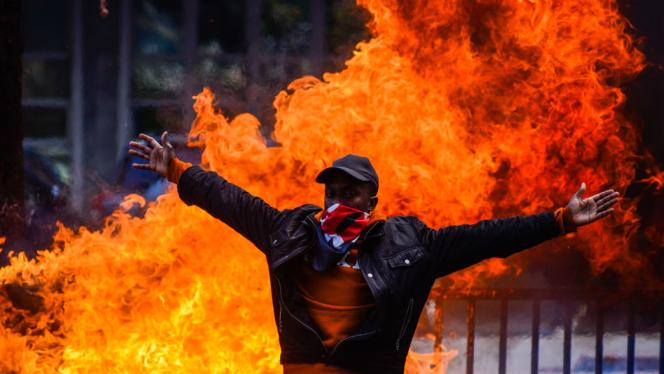Sunday 8 September 2024
Kenyan crisis: A tax uprising or a democracy ablaze

Ruto’s decision to withdraw his measure won’t stop a new democratic consciousness that has taken root among Kenya’s youth.
Kenya has once again been shaken by popular protests which started on 18 June, triggered by the so-called finance bill that proposes increasing taxes on various everyday products and services, including the internet, fuel, bank transfers, private cars, and even bread in order to finance the country’s ballooning debt. This means an unprecedented rise in living costs and a decrease in Kenyans’ purchasing power. Kenyan writer Nanjala Nyabola has hit back assertions that the bill is a much needed dose of austerity for Kenya, targeting people’s pockets directly instead of public spending which is more common. It is more akin to a “cash grab from the poor to sustain the lifestyles of the rich,” she says.
The situation escalated after the parliament, dominated by President William Ruto’s United Democratic Alliance, approved the bill on 25 June. Thousands of protesters gathered in front of the parliament building, carrying banners that read “No to tax imposition” and “No to economic dictatorship”. They stormed the building, setting part of it on fire and forcing the evacuation of lawmakers through an underground tunnel, an unprecedented event since Kenya’s independence in 1963.
The Kenyan police opened fire on the protesters, resulting in 22 deaths and hundreds of injuries and arrests, according to the Kenyan Human Rights Commission. The commission condemned the violent intervention by security forces, who used tear gas and water cannons despite the peaceful nature of the protests, which spread beyond the capital, Nairobi, to about 30 out of the country's 47 counties.
Taxes: An annual protest syndrome
Last summer, Kenyans protested against the newly-elected President William Ruto, who took office on 13 September 2022, after he said that his government needed more funds to tackle high inflation (8% annually), stimulate growth that had slowed to 4.8% in 2022 from 7.6% in 2021, and pay off debts accumulated during former President Uhuru Kenyatta’s tenure (2013–2022), which amounted to $69 billion. It should be recalled that Ruto was Kenyatta’s vice president, so unlike the incoming Labour leader in the UK, Ruto cannot argue that it was his predecessor’s profligate ways which have forced him to take these belt-tightening measures. He was in the room when the Kenyan government gorged on western and Chinese loans for incomplete, often unnecessary, and expensive infrastructure projects.
In 2023, the government accused protesters of “hooliganism and lawlessness”, and rammed the measures through arresting hundreds of people and killing at least three. Raila Odinga’s calls for civil disobedience and mass demonstrations, including lawmakers, didn’t stop Ruto’s penny-pinching repression. Some of the taxes he introduced, like the housing tax, are still being challenged in court.
Low on cash again this year, instead of searching for savings in Kenya’s bloated government or looking at the country’s MPs, who are the second-highest paid globally when accounting for GDP, Ruto attempted to capture lightning in a bottle once more by introducing a raft of new taxes. A cartoon by the Nation, depicted the government in the form of a well-fed, suited pig saying “welcome, our agenda is govt wastage”, with a bag of cash on a table emblazoned with: “sitting allowances”. This time, however, it has blown up in his face.
Ruto has worked to raise Kenya’s global profile, and while that has earned him invitations to Washington and the G7 meeting in Italy this year, it has also put a spotlight on the country. The brutal repression of the protests reached a global audience, with Al Jazeera, BBC and CNN providing live coverage from the ground for international viewers. Whilst Ruto has once again alleged that some of the protesters were violent rioters, the case of Ericsson Kyalo Mutisya, 25, paints a more disturbing picture. CNN’s Larry Madowo checked back through his footage after covering the protests and saw Mutisya dressed entirely in white, protesting in front of the parliament and clearly unarmed. As the footage continues and security forces closed in firing smoke bombs and bullets, Mutisya’s corpse is seen getting carried by two men.
The day after Ruto announced he was withdrawing the bill. “The people have spoken,” he said. That was meant to end the protests but just days later they went ahead again with a new demand: that Ruto step aside. The president has deployed the army to the country’s streets, but that also signals vulnerability. On Tuesday, a new package of salary increases for MPs also went through, sure to enrage youngsters keen to get the government out.
Hustler nation or hustlin’ nation?
President William Ruto, who served as vice president from 2013 to 2022, was elected nearly two years ago on the basis of a programme aimed at helping Kenya’s poor. He was even dubbed the “candidate of the poor and lower class” by local and international media, given his personal beginnings from a disadvantaged background and ran a campaign on the infamous slogan “hustler nation”. However, he has turned out to be the candidate of the IMF. Kenya has had a difficult run of late, with repeated heavy floods and droughts. Many of these problems have occurred on Ruto’s watch, so if there is slack to be cut, that needs to be acknowledged. But part of the reason he implemented these measures is because he’s seeking IMF support to manage Kenya’s crippling debt.
Some of the protesters have picked up on this angle, demonstrating a keen understanding of the power dynamics at play. They’ve moved to occupy the IMF and World Bank buildings in Nairobi, even organising sit-ins at the former. The youngsters heading to these protests understand that their president is being pressured (when they’re not egging him on) by an unaccountable international financial institution that has ruined many countries. The IMF said the likelihood that the finance bill would trigger protests was “medium”. The guy who was smoking a gas canister last week was definitely not “medium”. He was rightly furious.
The IMF claims that its actions in Kenya are intended to help it "overcome the difficult economic challenges it faces and to improve its economic prospects". How? It has pushed the Kenyan government into a corner, and its reflexive reaction has been to harm its own citizens. When the neoliberal securitised state isn’t causing harm directly to citizens, unemployment and poverty do so indirectly. As Hannah Ryder, CEO of Development Reimagined, recently pointed out in a piece for African Business the only reason Kenya is being forced into this uncomfortable fiscal corner is because the IMF has preferred creditor status, which means even if Kenya defaults on its other debt, what it owes the IMF is “un-relievable or un-restructurable”. It has to pay, come what may and that means cuts or squeezing civilians. Ryder adds that the fund’s lending to the “entire African continent accounts for just 10% of its total portfolio – and that does not account for the many financial instruments it has not targeted at these markets at all.” “Kenya or Ethiopia defaulting would hardly create a storm,” she continues.
It isn’t for no reason that Mehreen Khan, the Times economics editor, says the fund has been thrown into a “reputation crisis” over the issue. Ruto’s solution has been to claw back money from young professionals who have fought back and demonstrated an appetite and ingenuity in protests that appear set for the long haul.
Kenya: a democracy in search of glory
The events in Kenya have drawn global attention, with increasing interest in Nairobi. There has been talk of Kenya’s aspirations to become a regional leader in the Horn of Africa, leveraging favourable regional conditions due to Ethiopia’s diminished role amidst growing tensions between its central government and various regions.
The United Nations, the European Union, and major global capitals (12 European countries) have condemned the violence in Kenya. Regionally, Ugandan opposition leader and former presidential candidate Bobi Wine expressed support for the protesters, as did Julius Malema, leader of South Africa’s Economic Freedom Fighters party.
What stands out about the Kenyan youth uprising, according to many observers, is its non-political nature, unlike most political protests in the country’s history. It started online against the tax increases and soon evolved into mass demonstrations without any structured body or official leadership, leaving the Kenyan government unsure of who to address. Heated debates have taken place on Twitter Space between Kenyans wondering if their amorphous movement should assume a more fixed shape and figurehead, or if this repeats colonial patterns of imposing a leader to tame a movement. That is for them to decide. Either way these young people have shown that a new ethos and protest culture has emerged in Kenya, more civic in orientation, democratic in ethos and stubborn by temperament and represents a turning point in the country’s and the region’s history.










